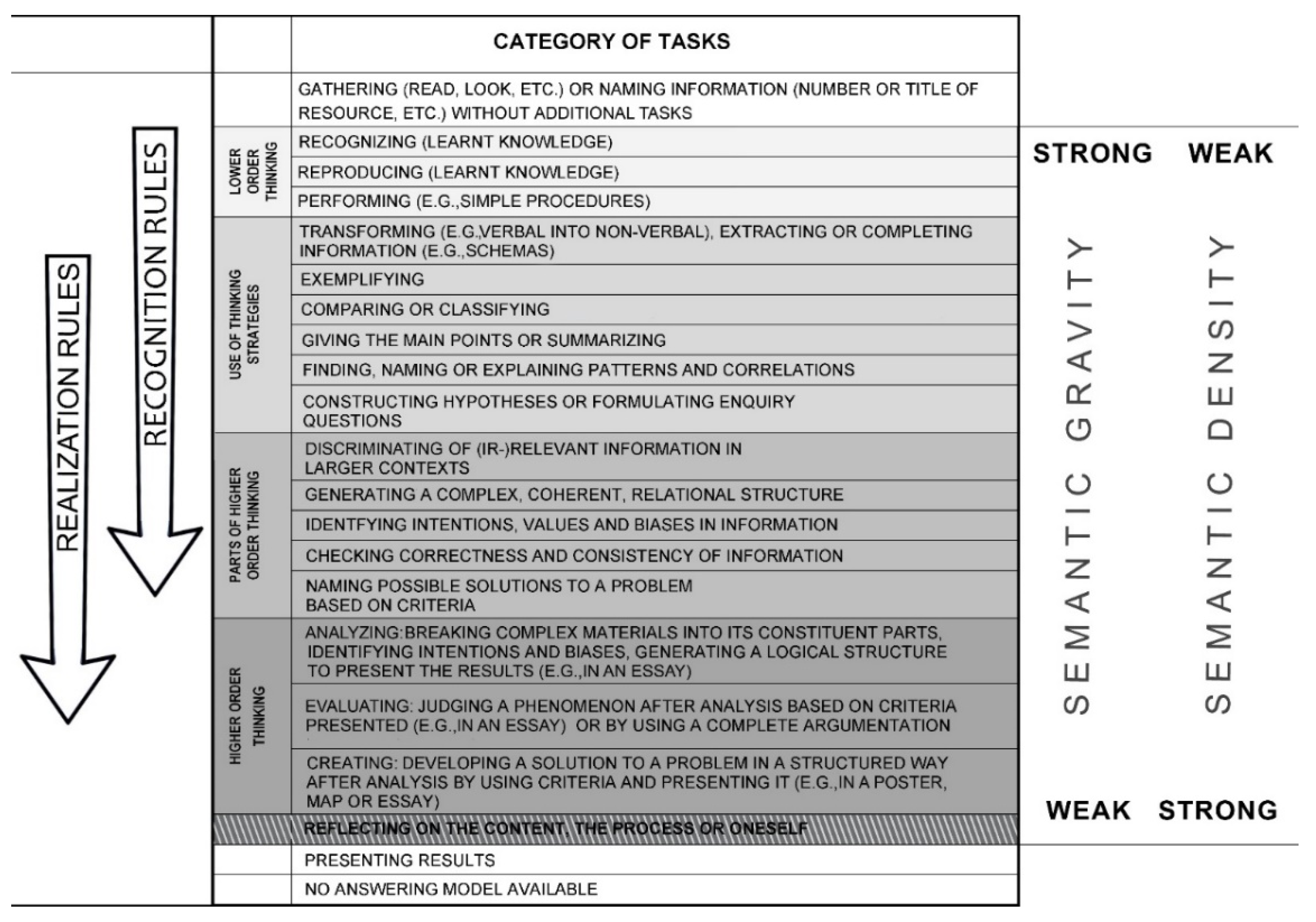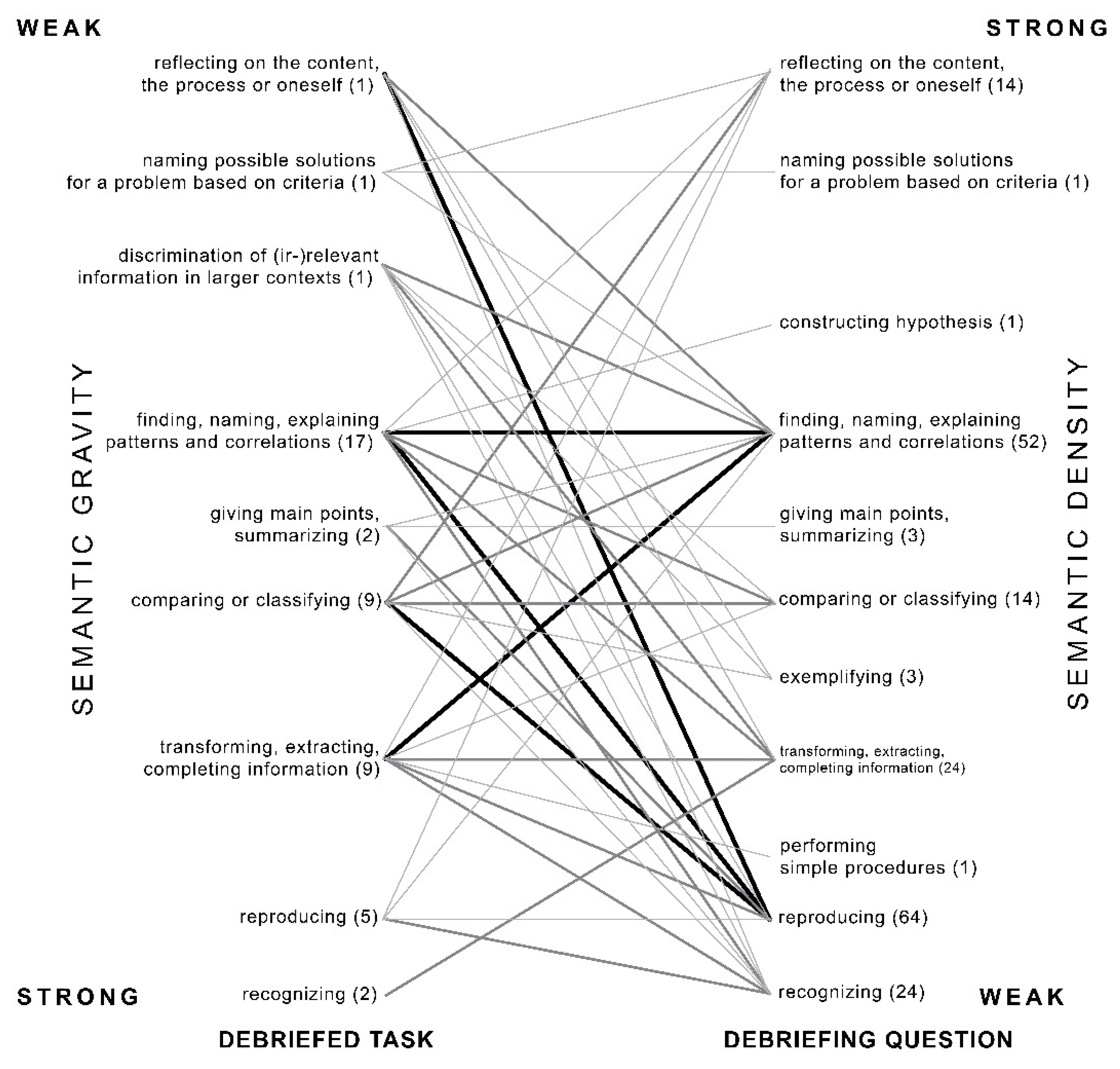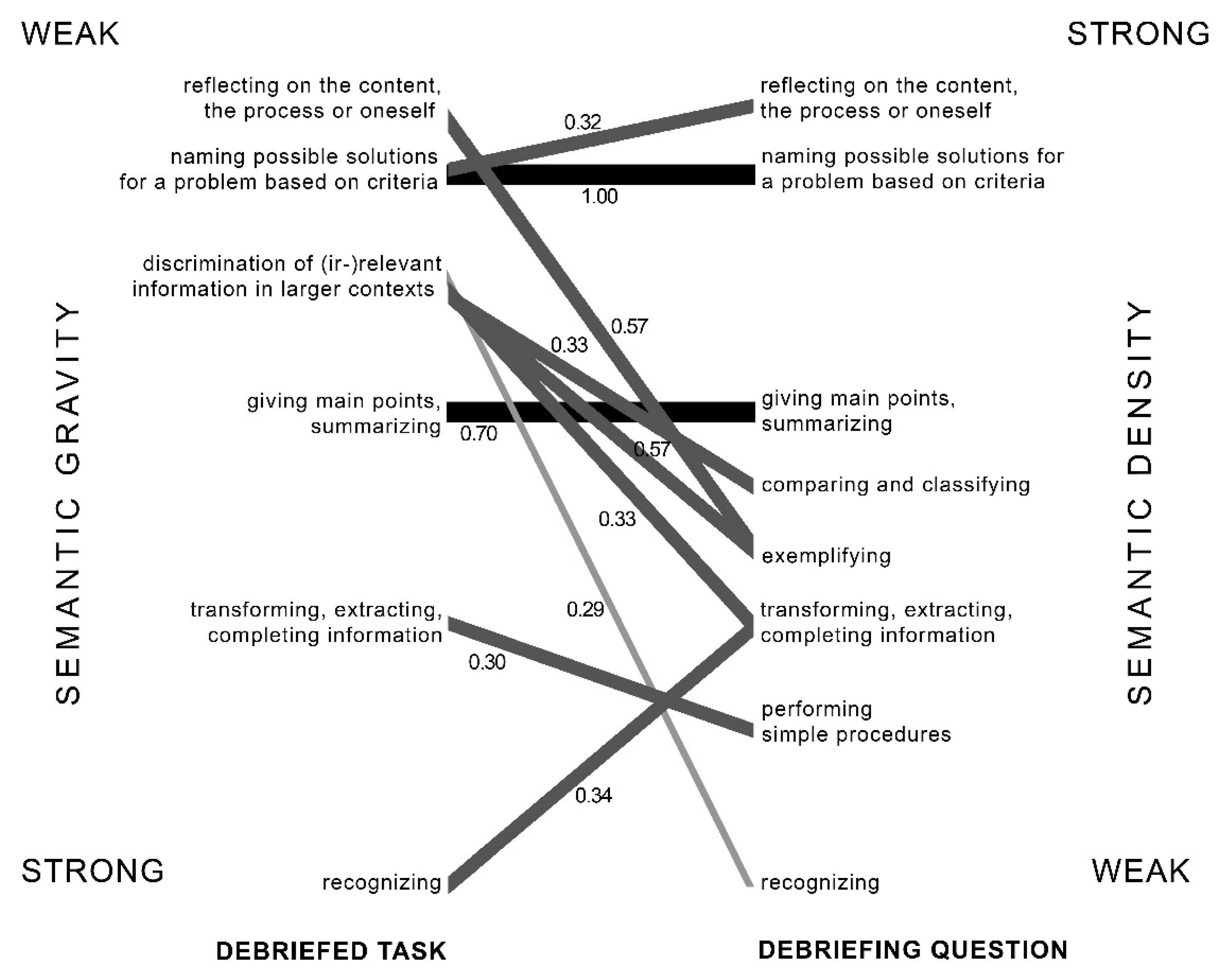Higher Order Thinking by Setting and Debriefing Tasks in Dutch Geography Lessons
Abstract
:1. Introduction
2. Theoretical Framework
2.1. The Context of the Recontextualization Process in Respect of Setting and Debriefing Tasks
2.2. Cognitive Processes Fostered by Tasks: Geography Task Categorization Framework
2.3. Tasks and the Development of Subject-Specific Competences
3. The Dutch Context in Respect of Setting and Debriefing Tasks
4. Research Question
To what extent are the tasks set in Dutch geography lessons for upper secondary in line with the intended curriculum?
What cognitive processes do the tasks set during geography lessons foster?
How are the results of the tasks discussed during the geography lessons?
5. Methodology
- If, how long (in seconds), and how many tasks were used,
- If, what and how many questions were asked by the teacher,
- If the tasks derived from the textbook (and which one) or not (selected by the teacher from other resources or developed by the teachers themselves), or originated from high-stakes exams from recent years,
- If the students worked individually, in pairs, in groups or as a whole class,
- If the students worked on tasks and if the tasks were debriefed.
6. Results
7. Discussion
8. Conclusions
Author Contributions
Funding
Institutional Review Board Statement
Informed Consent Statement
Data Availability Statement
Acknowledgments
Conflicts of Interest
References
- Kleinknecht, M. Aufgabenkultur im Unterricht: Eine Empirisch-Didaktische Video-und Interviewstudie an Hauptschulen, 1st ed.; Schneider Hohengehren: Baltmannsweiler, Germany, 2010. [Google Scholar]
- Krause, U.; Béneker, T.; Van Tartwijk, J.; Uhlenwinkel, A.; Bolhuis, S. How do the German and Dutch Curriculum Contexts influence (the Use of) Geography Textbooks? Rev. Int. Geogr. Educ. Online 2017, 7, 235–263. [Google Scholar]
- Krause, U.; Budke, A.; Maier, V. Understanding of Developping and Setting Tasks in Geography Lessons by German and Dutch Student Teachers. Educ. Sci. 2021, 11, 63. [Google Scholar] [CrossRef]
- Maton, K. Knowledge and Knowers. Towards a Realist Sociology of Education, 1st ed.; Routledge: Milton Park, UK, 2014. [Google Scholar]
- Winch, C. Curriculum design and epistemic ascent. J. Philos. Educ. 2013, 47, 128–146. [Google Scholar] [CrossRef]
- Hudson, B. Powerful knowledge and epistemic quality in school mathematics. Lond. Rev. Educ. 2018, 16, 384–397. [Google Scholar] [CrossRef]
- Maude, A. The role of geography’s concepts and powerful knowledge in a future 3 curriculum. Int. Res. Geogr. Environ. Educ. 2020, 29, 232–243. [Google Scholar] [CrossRef]
- Vernon, E. Teaching to the epistemic self: Ascending and descending the ladder of knowledge. Curric. J. 2020, 31, 27–47. [Google Scholar] [CrossRef]
- Meyer, H. Didaktische Modelle, 2nd ed.; Cornelsen Scriptor: Berlin, Germany, 2009. [Google Scholar]
- Bladh, G. GeoCapabilities, Didaktical analysis and curriculum thinking—Furthering the dialogue between Didaktik and curriculum. Int. Res. Geogr. Environ. Educ. 2020, 29, 206–220. [Google Scholar] [CrossRef]
- Diethelm, I.; Dörge, C.; Mesaros, A.; Dünnebier, M. Die Didaktische Reduktion für den Informatikunterricht. In Informatik in Bildung und Beruf. 14. GI-Fachtagung Informatik und Schule—INFOS 2011, Münster, Germany, 12–15 September 2011; Thomas, M., Ed.; Gesellschaft für Informatik e.V.: Bonn, Germany, 2011; pp. 77–86. [Google Scholar]
- Van den Akker, J. Curriculum Perspectives. An Introduction. In Curriculum Landscapes and Trends, 1st ed.; Van den Akker, J., Kuiper, W., Hameyer, U., Eds.; Kluwer: Dordrecht, The Netherlands; Boston, MA, USA; London, UK, 2003; pp. 1–10. [Google Scholar]
- Jordan, A.; Ross, N.; Krauss, S.; Baumert, J.; Blum, W.; Neubrand, M.; Löwen, K.; Brunner, M.; Kunter, M. (Eds.) Klassifikationsschema für Mathematikaufgaben: Dokumentation der Aufgabenkategorisierung im COACTIV-Projekt, 1st ed.; Max-Planck-Institut für Bildungsforschung: Berlin, Germany, 2006. [Google Scholar]
- Krause, U.; Béneker, T.; Van Tartwijk, J.; Maier, V. Curriculum contexts, recontextualisation and attention for higher-order thinking. Lond. Rev. Educ. 2021, 19, 1–17. [Google Scholar] [CrossRef]
- Bernstein, B. Pedagogy, Symbolic Control and Identity. Theory, Research, Critique, revised ed.; Rowman & Littlefield: Lanham, MD, USA, 2000. [Google Scholar]
- Krause, U.; Béneker, T.; Van Tartwijk, J. Thinking skills in geography textbook tasks of North Rhine Westphalia and the Netherlands. Int. Res. Geogr. Environ. Educ. 2021, 1–16. [Google Scholar] [CrossRef]
- Krause, U.; van Berkel, B.; Béneker, T. Krachtige kennis bij mondiale vraagstukken: Curriculumdoelen en schoolboekopdrachten. Dimensies. under revision.
- Bernstein, B. Class, Codes and Control. Volume 3. Towards a Theory of Educational Transmissions, 1st ed.; Routledge: London, UK; Boston, MA, USA, 1975. [Google Scholar]
- Bernstein, B. Class, Codes and Control. Volume 4. The Structuring of Pedagogic Discourse, 1st ed.; Routledge: London, UK, 1990. [Google Scholar]
- Bernstein, B. Vertical and Horizontal Discourse: An essay. Br. J. Sociol. Educ. 1999, 20, 157–173. [Google Scholar] [CrossRef]
- OECD. PISA 2018 Assessment and Analytical Framework, PISA, 1st ed.; OECD Publishing: Paris, France, 2019. [Google Scholar] [CrossRef]
- Virranmäki, E.; Valta-Hulkkonen, K.; Pellikka, A. Geography Curricula Objectives and Students’ Performance: Enhancing the Student’s Higher-Order Thinking Skills? J. Geogr. 2021, 120, 97–107. [Google Scholar] [CrossRef]
- Jo, I.; Bednarz, S.; Metoyer, S. Selecting and Designing Questions to Facilitate Spatial Thinking. Geogr. Teach. 2010, 7, 49–55. [Google Scholar] [CrossRef]
- Bijsterbosch, E. Professional Development of Geography Teachers with Regard to Summative Assessment Practices, 1st ed.; Ipskamp Printing: Enschede, The Netherlands, 2018. [Google Scholar]
- Ananda, A.; Nofrion, N. Higher-Order Thinking Skills Improvement in Geography Learning on Material of Atmospheric Dynamic. In Proceedings of the 1st International Conference on Education Social Sciences and Humanities, West Sumatera, Indonesia, 13–16 March 2019; Atlantis Press: Dordrecht, The Netherlands; Paris, France; Zhengzhou, China, 2019; pp. 947–956. [Google Scholar] [CrossRef]
- Lane, R.; Bourke, T. The inclusion of geography in TIMSS: Can consensus be reached? Int. Res. Geogr. Environ. Educ. 2016, 26, 166–176. [Google Scholar] [CrossRef]
- Anderson, L.; Krathwohl, D.; Airasian, P.; Cruikshank, K.; Mayer, R.; Pintrich, P.; Raths, J.; Wittrock, M. (Eds.) A Taxonomy for Learning, Teaching and Assessing. A Revision of Bloom’s Taxonomy of Educational Objectives, complete ed.; Longman: New York, NY, USA, 2001. [Google Scholar]
- Young, M. Education, globalisation and the “voice of knowledge”. J. Educ. Work. 2009, 22, 193–204. [Google Scholar] [CrossRef]
- Stoltman, J.; Lidstone, J.; Kidman, G. Powerful Knowledge in geography: IRGEE editors interview Professor David Lambert, London Institute of Education. Int. Res. Geogr. Environ. Educ. 2015, 24, 1–5. [Google Scholar] [CrossRef]
- Béneker, T. Powerful Knowledge in Geography Education. Inaugural Lecture Given by Tine Béneker at the Acceptance of the Position of Professor of Geography & Education, at the Faculty of Geosciences, Utrecht University, at October 16th 2018; Universiteit Utrecht: Utrecht, The Netherlands, 2018. [Google Scholar]
- Menck, P. Aufgaben—Der Dreh- und Angelpunkt von Unterricht. In Aufgaben im Schulbuch, 1st ed.; Matthes, E., Schütze, S., Eds.; Julius Klinkhardt: Bad Heilbrunn, Germany, 2011; pp. 19–29. [Google Scholar]
- Roberts, M. Geographical education is powerful if …. Teach. Geogr. 2017, 42, 6–9. [Google Scholar]
- Taylor, L. Key concepts and medium term planning. Teach. Geogr. 2008, 33, 50–54. [Google Scholar]
- Goemans, A.; Steegen, A. Differentiatie in de Lessen Aardrijkskunde. Een Haalbare Kaart. Technieken en Methoden; Acco: Leuven, Belgium, 2015. [Google Scholar]
- Feretti, J. Differentiation. In The Handbook of Secondary Geography, 1st ed.; Jones, M., Ed.; Geographical Association: Sheffield, UK, 2017; pp. 166–181. [Google Scholar]
- Rhode-Jüchtern, T. Gestaltung von Lernumgebungen. In Geographiedidaktik. Ein Arbeitsbuch zur Gestaltung des Geographieunterrichts, 1st ed.; Kanwischer, D., Ed.; Borntraeger: Stuttgart, Germany, 2013; pp. 105–116. [Google Scholar]
- German Geographical Society (Ed.) Educational Standards in Geography for the Intermediate School Certificate with Sample Assignments, 3rd ed.; German Geographical Society: Bonn, Germany, 2014. [Google Scholar]
- Tillmann, A. Gestaltung kompetenzorientierten Geographieunterrichts—Integration pädagogischer Diagnoseverfahren zur individuellen Förderung von Schülern. In Geographische Bildung: Kompetenzen in Didaktischer Forschung und Schulpraxis, 1st ed.; Meyer, C., Henrÿ, R., Stöber, G., Eds.; Westermann: Braunschweig, Germany, 2011; pp. 147–160. [Google Scholar]
- Vankan, L.; Van der Schee, J. Leren Denken Met Aardrijkskunde, 1st ed.; Stichting Omgevingeducatie: Nijmegen, The Netherlands, 2004. [Google Scholar]
- Rempfler, A.; Uphues, R. Systemkompetenz im Geographieunterricht—Die Entwicklung eines Kompetenzmodells. In Geographische Bildung. Kompetenzen in didaktischer Forschung und Praxis, 1st ed.; Meyer, C., Henrÿ, R., Stöber, G., Eds.; Westermann: Braunschweig, Germany, 2011; pp. 36–48. [Google Scholar]
- Nichols, A. Thinking skills and the role of debriefing. In Secondary Geography Handbook, 1st ed.; Balderstone, D., Ed.; Geographical Association: Sheffield, UK, 2006; pp. 180–197. [Google Scholar]
- Hattie, J. Visible Learning. A Synthesis of over 800 Meta-Analyses Relating to Achievement, 1st ed.; Routledge: London, UK, 2009. [Google Scholar]
- Budke, A.; Meyer, M. Fachlich argumentieren lernen—Die Bedeutung der Argumentation in den unterschiedlichen Schulfächern. In Fachlich Argumentieren Lernen. Didaktische Forschungen zur Argumentation in den Unterrichtsfächern, 1st ed.; Budke, A., Kuckuck, M., Meyer, M., Schäbitz, F., Schlüter, K., Weiss, G., Eds.; Waxmann: Münster, Germany, 2015; pp. 9–28. [Google Scholar]
- Uhlenwinkel, A. Geographisches Wissen und Geographische Argumentation. In Fachliches Argumentieren Lernen. Didaktische Forschungen zur Argumentation in den Unterrichtsfächern, 1st ed.; Budke, A., Kuckuck, M., Meyer, M., Schäbitz, F., Schlüter, K., Weiss, G., Eds.; Waxmann: Münster, Germany, 2015; pp. 46–61. [Google Scholar]
- Inspectie van Het Onderwijs. Verschil SE-CE en de Handhaving op de Examenlicentie. 2020. Available online: https://www.onderwijsinspectie.nl/onderwerpen/onderwijsresultatenmodel-vo/nieuw-model/verschil-se-ce-en-de-handhaving-op-de-examenlicentie (accessed on 8 January 2021).
- Zemanek, E.; Nerbig, A. Komparatistik, 1st ed.; Akademie Verlag: Berlin, Germany, 2012. [Google Scholar]
- Kuckartz, U. Einführung in Die Computergestützte Analyse Qualitativer Daten, 3rd ed.; Verlag für Sozialwissenschaften: Wiesbaden, Germany, 2010. [Google Scholar]
- Ormeling, F.; Kraak, M. Kartografie. Visualisatie van Ruimtelijke Gegevens, 1st ed.; Koninklijke Bibliotheek: Den Haag, The Netherlands, 1987. [Google Scholar]
- Agirdag, O.; Biesta, G.; Bosker, R.; Kuiper, R.; Nieveen, N.; Raaijmakers, M.; van Tartwijk, J. Examenprogramma’s in Perspectief:. Tussenadvies 3 Wetenschappelijke Commissie; Curriculumcommissie: Amersfoort, The Netherlands, 2021. [Google Scholar]
- Widdowson, A.; Lambert, D. Using Geography Textbooks. In Secondary Geography Handbook, 1st ed.; Balderstone, D., Ed.; Geographical Association: Sheffield, UK, 2006; pp. 146–159. [Google Scholar]
- Hamann, B. Das Weltbild in US-amerikanischen High School “World Geography”—Lehrwerken, 1st ed.; Friedrich-Alexander-Universität Erlangen-Nürnberg: Erlangen, Germany, 2004. [Google Scholar]
- Van der Vaart, R. Kiezen en Delen. Beschouwingen over de Inhoud van Het Schoolvak Aardrijkskunde, 1st ed.; Utrecht University: Utrecht, The Netherlands, 2001. [Google Scholar]
- KNAG Commissie Aardrijkskunde Tweede Fase. Gebieden in Perspectief. Natuur en Samenleving, Nabij en Veraf: Voorstel Voor nieuwe Examenprogramma’s Aardrijkskunde in de Tweede Fase van Havo en vwo, 1st ed.; Koninklijk Nederlands Aardrijkskundig Genootschap: Utrecht, The Netherlands, 2003. [Google Scholar]
- Stogiannidis, A.; Koutsoupias, N. Geometric Didactic Analysis (Ge. Di. An.)—Methodologische Überlegungen zu einer didaktischen Schulbuchforschung und Fallstudie (Aufgabenanalyse). In Methodologie und Methoden der Schulbuch- und Lernmittelforschung, 1st ed.; Knecht, P., Matthes, E., Schütze, S., Aamotsbakken, B., Eds.; Julius Klinkhardt: Bad Heilbrunn, Germany, 2014; pp. 99–110. [Google Scholar]
- Flath, M. Geographisches Schulbuch und Kompetenzerwerb—Konzeptionelle Ansätze für kompetenzorientiertes Lehren und Lernen mit einem traditionellen Medium. In Geographische Bildung. Kompetenzen in Didaktischer Forschung und Schulpraxis, 1st ed.; Meyer, C., Henrÿ, R., Stöber, G., Eds.; Westermann: Braunschweig, Germany, 2011; pp. 58–67. [Google Scholar]
- Janssen, F. Grip Krijgen op Complexiteit. Onderwijs voor Het ‘Moeras’. Oratie in Verkorte Vorm Uitgesproken Door Prof.dr.ir. Fred Janssen bij de Aanvaarding van Het Ambt van Hoogleraar in de Didactiek van de Natuurwetenschappen aan de Universiteit Leiden op 19 Juni 2017; Leiden University: Leiden, The Netherlands, 2017. [Google Scholar]
- Hemmer, I.; Hemmer, M. Teachers’ Interests in Geography Topics and Regions–How they Differ from Students’ Interests? Empirical Findings. Rev. Int. Geogr. Educ. Online (RIGEO) 2017, 7, 9–23. [Google Scholar]



| Average Lesson Time in Minutes | Average Effective Lesson Time in Minutes | Average Time Spent on Making Tasks in % of the Effective Lesson Time | Average Time spent on Debriefing Time in % of the Effective Lesson Time | Average Time spent Simultaneously on Making and Debriefing Task in % of the Effective Lesson Time |
|---|---|---|---|---|
| 46:17 | 42:09 | 27% | 22% | 25% |
| Number of Tasks | Percentage of Tasks Set during Lessons According the Geography Task Categorization Framework | ||||||||||||
|---|---|---|---|---|---|---|---|---|---|---|---|---|---|
| Lower Order Thinking (Lot) | Use of Thinking Strategies (Uts) | Parts of Higher Order Thinking (Phot) | Metacognition | ||||||||||
| Type of task 1 | 1 | 2 | 3 | 4 | 5 | 6 | 7 | 8 | 9 | 10 | 11 | 15 | 19 |
| 238 | 1.3 | 7.6 | 21.4 | 1.7 | 21.0 | 0.8 | 11.3 | 0.4 | 32.4 | 0.8 | 0.4 | 0.4 | 0.4 |
| Number of Tasks | Percentage of Tasks during Debriefing According the Geography Task Categorization Framework | |||||||||
|---|---|---|---|---|---|---|---|---|---|---|
| Lower Order Thinking (Lot) | Use of Thinking Strategies (Uts) | Parts of Higher Order Thinking (Phot) | Metacognition | |||||||
| Type of task 1 | 2 | 3 | 4 | 5 | 7 | 8 | 9 | 11 | 15 | 19 |
| 96 | 8.3 | 16.7 | 2.1 | 10.4 | 20.1 | 2.1 | 35.4 | 1.0 | 1.0 | 2.0 |
| Number of Questions | Percentage of Questions during Debriefing of Tasks According the Geography Task Categorization Framework | |||||||||||
|---|---|---|---|---|---|---|---|---|---|---|---|---|
| Lower Order Thinking (Lot) | Use of Thinking Strategies (Uts) | Parts of Higher Order Thinking (Phot) | Metacognition | |||||||||
| Type of question 1 | 2 | 3 | 4 | 5 | 6 | 7 | 8 | 9 | 10 | 11 | 15 | 19 |
| 210 | 12.9 | 31.9 | 0.5 | 11.9 | 1.9 | 6.7 | 1.4 | 25.7 | 0.5 | 0.5 | 0.5 | 7.6 |
Publisher’s Note: MDPI stays neutral with regard to jurisdictional claims in published maps and institutional affiliations. |
© 2021 by the authors. Licensee MDPI, Basel, Switzerland. This article is an open access article distributed under the terms and conditions of the Creative Commons Attribution (CC BY) license (https://creativecommons.org/licenses/by/4.0/).
Share and Cite
Krause, U.; Béneker, T.; van Tartwijk, J. Higher Order Thinking by Setting and Debriefing Tasks in Dutch Geography Lessons. Eur. J. Investig. Health Psychol. Educ. 2022, 12, 11-27. https://doi.org/10.3390/ejihpe12010002
Krause U, Béneker T, van Tartwijk J. Higher Order Thinking by Setting and Debriefing Tasks in Dutch Geography Lessons. European Journal of Investigation in Health, Psychology and Education. 2022; 12(1):11-27. https://doi.org/10.3390/ejihpe12010002
Chicago/Turabian StyleKrause, Uwe, Tine Béneker, and Jan van Tartwijk. 2022. "Higher Order Thinking by Setting and Debriefing Tasks in Dutch Geography Lessons" European Journal of Investigation in Health, Psychology and Education 12, no. 1: 11-27. https://doi.org/10.3390/ejihpe12010002
APA StyleKrause, U., Béneker, T., & van Tartwijk, J. (2022). Higher Order Thinking by Setting and Debriefing Tasks in Dutch Geography Lessons. European Journal of Investigation in Health, Psychology and Education, 12(1), 11-27. https://doi.org/10.3390/ejihpe12010002






